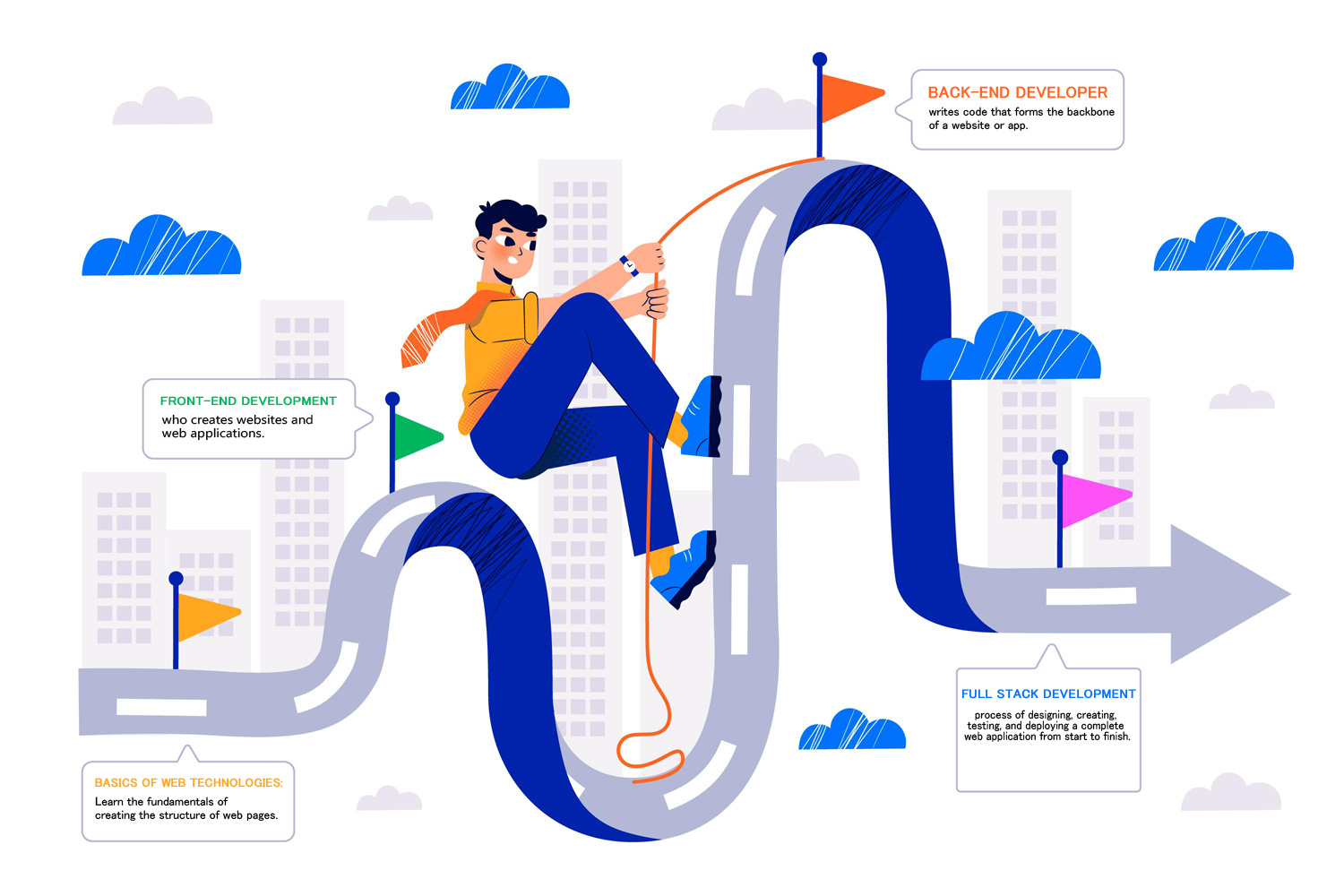How to Start Web Development? Full Stack Web Developer Roadmap Step-by-Step
Starting web development as a Full Stack Developer can be an exciting journey. Below is a step-by-step roadmap to guide you through the process. Keep in mind that the field of web development is constantly evolving, so it’s essential to stay up-to-date with the latest technologies and best practices.
- Basics of Web Technologies:
- HTML: Learn the fundamentals of creating the structure of web pages.
- CSS: Understand how to style and design web pages.
- JavaScript: Get a solid foundation in JavaScript, as it’s the core programming language of the web.
- Version Control System:
- Git: Learn how to use Git for version control to manage you’re codebase efficiently.
- Front-End Development:
- Front-End Frameworks: Start with popular frameworks like React, Angular, or Vue.js. Choose one and get comfortable with it.
- CSS Preprocessors: Learn tools like Sass or Less to enhance your CSS workflow.
- Responsive Design: Understand how to make your websites adapt to different screen sizes and devices.
- Web Tools: Familiarize yourself with build tools like Web Pack, Babel, and task runners like Gulp or Grunt.
- Back-End Development:
- Server-Side Language: Choose a language for server-side development like Node.js (JavaScript), Python, Ruby, Java, or PHP.
- Frameworks: Learn popular frameworks like Express (Node.js), Flask (Python), Ruby on Rails (Ruby), Spring (Java), or Laravel (PHP).
- Databases: Get acquainted with databases like MySQL, PostgreSQL, MongoDB, or SQLite.
- Databases:
- Learn about relational databases (e.g., SQL) and NoSQL databases (e.g., MongoDB) to store and retrieve data.
- API (Application Programming Interface):
- Understand how to build and consume APIs, which are essential for connecting front-end and back-end components.
- Full Stack Development:
- Integrate the front-end and back-end to create a complete web application.
- Work on projects that involve end-to-end development to gain practical experience.
- Authentication and Authorization:
- Learn about user authentication and authorization to secure your applications.
- Deployment:
- Deploy your applications to hosting services like Heroku, AWS, or Netlify.
- Performance Optimization:
- Learn techniques to optimize your web application’s performance, such as code splitting, lazy loading, and caching.
- Testing:
- Learn about the unit, integration, and end-to-end testing to ensure your application works as expected.
- Security:
- Study common web application security vulnerabilities and how to prevent them.
- Continuous Integration and Deployment (CI/CD):
- Learn how to set up CI/CD pipelines to automate the deployment process.
- Progressive Web Apps (PWA):
- Understand how to build PWAs to provide a better user experience.
- Web Sockets and Real-Time Communication:
- Explore real-time communication technologies to build interactive applications.
- Frameworks and Libraries:
- Keep up-to-date with the latest trends and updates in front-end and back-end frameworks and libraries.
- Soft Skills:
- Effective communication, teamwork, and problem-solving are essential skills in a development team.
- Continuous Learning:
- Web development is continuously evolving. Stay curious and keep learning new technologies and best practices.
Remember that becoming a Full Stack Developer takes time and practice. Start with the basics, build small projects, and gradually work on more complex applications. Participate in coding challenges, join open-source projects, and collaborate with other developers to enhance your skills.
Additional steps to consider as you progress:
- Mobile Development:
-
- Consider learning mobile development using technologies like React Native, Flutter, or native development (iOS with Swift/Objective-C, Android with Java/Kotlin).
- UI/UX Design:
-
- Understanding UI/UX principles will help you create user-friendly and visually appealing applications.
- Web Accessibility:
-
- Learn how to make your applications accessible to users with disabilities, following WCAG guidelines.
- Serverless Architecture:
-
- Explore serverless technologies like AWS Lambda, Azure Functions, or Google Cloud Functions to build scalable applications without managing servers.
- Microservices Architecture:
-
- Understand the concept of microservices and how to design and build applications using this architecture.
- Containerization and Orchestration:
-
- Learn about Docker for containerization and Kubernetes for orchestrating and managing containerized applications.
- GraphQL:
-
- Familiarize yourself with GraphQL, a query language for APIs that offers more flexibility than traditional REST APIs.
- Web Security:
-
- Dive deeper into web application security, including OWASP’s Top 10 vulnerabilities and best practices for secure coding.
- Data Structures and Algorithms:
-
- Strengthen your problem-solving skills by studying data structures and algorithms.
- Web Performance:
-
- Explore techniques like lazy loading, code splitting, and image optimization to improve web application performance.
- Server-Side Rendering (SSR) and Static Site Generation (SSG):
-
- Learn about SSR and SSG to improve SEO and performance for your web applications.
- AI and Machine Learning:
-
- Consider integrating AI and ML into your applications using libraries like TensorFlow.js or Python’s TensorFlow and sci-kit-learn.
- Blockchain and Smart Contracts:
-
- If you’re interested, explore blockchain development and smart contracts using platforms like Ethereum.
- Web Analytics and Monitoring:
-
- Learn how to use tools like Google Analytics and application monitoring services to gather insights and improve your app’s performance.
- Cross-Browser Compatibility:
-
- Ensure your applications work smoothly across different browsers and devices.
- Best Practices and Code Reviews:
-
- Embrace best practices and participate in code reviews to learn from experienced developers.
- Soft Skills Development:
-
- Communication, teamwork, and adaptability are crucial for success in a development team.
Remember that becoming a Full Stack Developer is a continuous journey. Always stay curious, be open to new technologies, and never stop learning. The web development landscape is dynamic, and being proactive in learning new skills will set you on a path to becoming a proficient and sought-after Full Stack Developer. Good luck on your web development journey!







